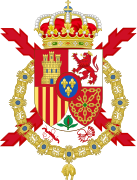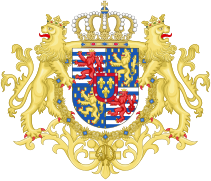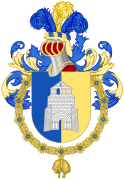Order of the Golden Fleece
The Insigne Order of the Golden Fleece is an order of chivalry founded in 1429 by the Duke of Burgundy and Count of Flanders, Philip III of Burgundy. It is one of the most prestigious and oldest chivalric orders in Europe, and is closely linked to the Habsburg dynasty and the crowns of Austria and Spain. The current Grand Master of the Spanish branch is Felipe VI, King of Spain, and the current Grand Master of the Austrian branch is Charles of Habsburg-Lorraine, head of the House of Habsburg. They are attached to the title of Excellence, as long as their holder does not have another of higher rank.
History
Origins in the Duchy of Burgundy
From the time of Richard I the Justiciero in 880 until the arrival of Philip III the Good of Burgundy in 1419, the Duchy of Burgundy gradually became an economically powerful territory. Felipe III tried to convert the duchy into a new State located between France and the Holy Empire, thus recovering the old kingdom of Lotharingia, which emerged from the inheritance of Charlemagne. Felipe III, through inheritance, incorporated the counties of Flanders, Artois, the duchies of Brabant, Luxemburg and Limburg into his power, together with the fiefdoms of Hainaut, Zeeland and Holland. Therefore, Felipe III the Good was also called Grand Duke of the West.
It was necessary to create an institution to guarantee the fidelity of the great men of all those territories in exchange for allowing them to participate in political life. England was an ally of this duchy and in 1422 Felipe III was elected a member of the Order of the Garter, but he refused so as not to clash with the King of France, Charles VII of Valois. Therefore, he chose to create his own order, the Order of the Golden Fleece, inspired by the model of the Order of the Garter.
The Dukes of Burgundy already had a previous knightly order, the Order of the Passion, which had been constituted with similar protocols and packaging to the Order of the Dragon. The principles of the Order of the Fleece were also related to the fight against Ottoman rule and the liberation of the Holy Places.
Its constitution is carried out in 1429 commemorating the celebration of his marriage with the Portuguese princess Isabel de Avis, daughter of the King of Portugal Juan I, a wedding that took place in the city of Bruges on January 10, 1430.
Following its English model, the Order was originally restricted to a limited number of knights, first 24 but increased to 30 in 1433 and 51 in 1516. Members of the Order could not be "heretics" and therefore became in an exclusively Catholic distinction during the Reformation.
The bull confirming the Order and approving its constitutions and ordinances was given by Pope Eugenius IV on September 7, 1433, with four dignities of the Order: the chancellor, the treasurer, the king of arms and the Secretary.
Evolution
Philip III celebrated ten chapters of the Order. In the seventh chapter, meeting in Ghent, Alfonso the Magnanimous, King of Aragon, was the first non-Burgundian to receive the necklace. Duke Carlos the Bold, heir to Philip III, introduced greater pageantry into the ceremonial, the clothing, the conclave and religious services.
Carlos died in 1477 and the inheritance of the title corresponded to his daughter Maria de Borgoña, however, at that time a woman could not preside over the Order, so this title went to her husband, the Holy Roman Emperor Germanic Maximilian I of Austria, father of Philip I the Fair and grandfather of Holy Roman Emperor Charles I of Spain and V of Germany. With these two monarchs there was a link between the Order and Spain, while they are linked to the Duchy of Burgundy. The great mastership would correspond to the title of king of Spain by bulls of the pontiffs Gregorio XIII, of 1574, and of Clemente VIII, of 1600.
Symbols

The ram was already a symbol of the city of Bruges, which had an important wool industry. By choosing the Golden Fleece, the duke was referring to the legend of Jason on the ship Argo. This was also linked to the new seafaring vocation of Burgundy thanks to its ports in the Netherlands.
In the legend, Jason must go to Colchis, present-day Georgia, where the Thracians spread sheepskins in the gold-bearing rivers to cover them with flakes of gold and then left them on a tree to dry. Jason had to rescue the golden fleece from a cypress to return it to Hellas and justly occupy the throne of Iolcos. The Argonauts, including Hercules, were to help him in his endeavor. Jason could represent Philip III and the Argonauts would be the men who are with him in the order.
The links of the Grand Master's necklace have the letter B, referring to Burgundy. Between the links is the flame, symbol of Prometheus, ultimate guarantor of the fleece, but also the symbol that appears on the duke's badge labeled with the motto: «Ante ferit quam flamma micet» («Hit before for the flame to be seen").
To this Greek symbol another Christian symbol was added. Gideon, Israel's judge, had asked God to show favor to him by letting dewdrops fall on a lamb's skin before attacking the Midianite army with only 300 men. The dewdrops were also related to the purity of the Virgin, to whom the Order was entrusted. The patron saint of Burgundy and of the Order was Saint Andrew, who had been martyred on an X-shaped cross, so this cross is also very important in the order's symbology. The B of the necklace is also joined to form the cross.
Chapters of the Order

| Number | Year | Sovereign Grand Master | Place of celebration |
|---|---|---|---|
| I | 1431 | Philip III of Burgundy | Lille |
| II | 1432 | Philip III of Burgundy | Bruges |
| III | 1433 | Philip III of Burgundy | Dijon |
| IV | 1435 | Philip III of Burgundy | Brussels |
| V | 1436 | Philip III of Burgundy | Lille |
| VI | 1440 | Philip III of Burgundy | Saint-Omer |
| VII | 1445 | Philip III of Burgundy | Ghent |
| VIII | 1451 | Philip III of Burgundy | Mons |
| IX | 1456 | Philip III of Burgundy | The Hague |
| X | 1461 | Philip III of Burgundy | Saint-Omer |
| XI | 1468 | Carlos el Temerario | Bruges |
| XII | 1473 | Carlos el Temerario | Okay. |
| XIII | 1478 | Maximilian of Habsburg | Bruges |
| XIV | 1481 | Maximilian of Habsburg | Bolduque |
| XV | 1491 | Philip the Beautiful | Malinas |
| XVI | 1501 | Philip the Beautiful | Brussels |
| XVII | 1505 | Philip the Beautiful | Middelburg |
| XVIII | 1516 | Carlos I de España | Brussels |
| XIX | 1519 | Carlos I | Barcelona |
| XX. | 1531 | Carlos I | Tournai |
| XXI | 1546 | Carlos I | Utrecht |
| XXII | 1555 | Philip II | Antwerp |
| XXIII | 1559 | Philip II | Ghent |
Grand Masters of the Order
 Philip III, Duke of Burgundy, founder (10 January 1430-1467).
Philip III, Duke of Burgundy, founder (10 January 1430-1467). Carlos «the Temerario», Duke of Burgundy (1467-1477).
Carlos «the Temerario», Duke of Burgundy (1467-1477). Maximilian I, emperor of the Holy Roman German Empire (1478-1482).
Maximilian I, emperor of the Holy Roman German Empire (1478-1482). Philip I, King of Castile and Duke of Burgundy (1482-1506).
Philip I, King of Castile and Duke of Burgundy (1482-1506). Charles I, king of Spain and emperor of the Holy Roman German Empire (1506-1555).
Charles I, king of Spain and emperor of the Holy Roman German Empire (1506-1555). Philip II, King of Spain and Portugal (1555-1598).
Philip II, King of Spain and Portugal (1555-1598). Philip III, King of Spain and Portugal (1598-1621).
Philip III, King of Spain and Portugal (1598-1621). Philip IV, King of Spain and Portugal (1621-1665).
Philip IV, King of Spain and Portugal (1621-1665). Charles II, King of Spain (1665-1700).
Charles II, King of Spain (1665-1700).
On the death of Charles II of Spain, the two pretenders to the throne, Philip of Anjou (future Philip V) and Archduke Charles (future Holy Roman Emperor Charles VI), held the dignity of Grand Masters of the order.
In 1725, a treaty between the two sovereigns recognized Charles VI as Grand Master for life. However, after his death, the Holy Roman Emperors first and those of Austria later continued to hold the grand mastership of the Austrian branch of the order, despite the protests of the Spanish sovereigns, who questioned its legitimacy.
Grand Masters of the Golden Fleece in Spain
 Philip V, king of Spain (1700-1724 and 1724-1746).
Philip V, king of Spain (1700-1724 and 1724-1746). Louis I, King of Spain (1724).
Louis I, King of Spain (1724). Fernando VI, king of Spain (1746-1759).
Fernando VI, king of Spain (1746-1759). Charles III, King of Spain (1759-1788).
Charles III, King of Spain (1759-1788). Charles IV, King of Spain (1788-1808).
Charles IV, King of Spain (1788-1808).
- There were certain disputes about their concession during the War of Independence. The fact that King Joseph I arrogated from the master of the order and granted the Golden Toy to Napoleon caused the anger of the exiled king of France Louis XVIII, who returned his distinction in protest. On his return, King Fernando VII reversed all the distinctions granted by Joseph Bonaparte.
- In 1812, the Spanish Regency granted the Golden Toy to the Duke of Wellington, which was confirmed by King Fernando VII when he took power in 1813, after consulting him with Pope Pius VII. Thus, the Duke of Wellington was the first Protestant to hold this distinction. Later, Orthodox Christians also received this dignity.
- Also during the Carlist Wars, the supporters of Carlos María Isidro de Borbón questioned the legitimacy of Isabel II as a great master of the Order and its right to grant the Golden Toy.
 Amadeo I, king of Spain (1870-1873).
Amadeo I, king of Spain (1870-1873). Alfonso XII, King of Spain (1874-1885).
Alfonso XII, King of Spain (1874-1885). Alfonso XIII, king of Spain (1886-1931; great master until 1941).
Alfonso XIII, king of Spain (1886-1931; great master until 1941). Juan de Borbón y Battenberg, pretender to the throne of Spain and Count of Barcelona (1941-1977).
Juan de Borbón y Battenberg, pretender to the throne of Spain and Count of Barcelona (1941-1977). Juan Carlos I, king of Spain (1977-2014).
Juan Carlos I, king of Spain (1977-2014). Philip VI, King of Spain (2014-present).
Philip VI, King of Spain (2014-present).
Grand Masters of the Golden Fleece in Austria
Philip of Anjou was proclaimed King of Castile in the Cortes on May 8, 1701, receiving the dignity of Grand Master of the Order. Furthermore, on September 17 he swore the fueros of Aragon and on October 4, 1701 he swore the Catalan constitutions. In May 1702, the War of the Succession in Europe began, after which most of the territories of the Crown of Aragon rose up against Felipe V. This war came to an end with the Treaty of Utrecht in 1713, where Felipe de Borbón was recognized as King of Spain.
From 1711 Charles of Austria became Holy Roman Emperor and awarded fleeces on his own, thus creating the Austrian branch of the order, separated from the Spanish. In 1725 Felipe V and Carlos VI signed the Treaty of Cambray by which, although Felipe V did not renounce the mastership, the emperor was allowed to use the titles acquired for life, so as not to strip him of his dignities, although this right over them would have been to extinguish with his death, which he did not fulfill, and the title of grand master was inherited by subsequent emperors and heads of the House of Austria to the present day.
Thus the masters of the Austrian Order of the Golden Fleece are:
 Charles VI, emperor of the Holy Roman German Empire (1725-1740).
Charles VI, emperor of the Holy Roman German Empire (1725-1740). Francis I, emperor of the Holy Empire and Duke of Lorraine (1740-1765).
Francis I, emperor of the Holy Empire and Duke of Lorraine (1740-1765). Joseph II, emperor of the Holy Empire (1765-1790).
Joseph II, emperor of the Holy Empire (1765-1790). Leopoldo II, emperor of the Holy Empire (1790-1792).
Leopoldo II, emperor of the Holy Empire (1790-1792). Francis II, emperor of the Holy Empire (1792-1835).
Francis II, emperor of the Holy Empire (1792-1835). Fernando I, emperor of Austria (1835-1848).
Fernando I, emperor of Austria (1835-1848). Francis Joseph I, emperor of Austria (up to 1867) and then Austria-Hungary (1848-1916).
Francis Joseph I, emperor of Austria (up to 1867) and then Austria-Hungary (1848-1916). Charles I, emperor of the Austro-Hungarian Empire (1916-1922).
Charles I, emperor of the Austro-Hungarian Empire (1916-1922).
After the disappearance of the Austro-Hungarian Empire, King Albert I of Belgium demanded that the dignity of grand master and the treasure of the Order be transferred to him as sovereign of the lands of Burgundy. This claim came to be seriously considered during the negotiations of the Treaty of Versailles, but ultimately rejected due to the intervention of King Alfonso XIII of Spain, who took possession of the Order's properties on behalf of the dethroned Emperor Charles I of Austria and IV of Hungary.
The Government of the Republic of Austria recognized in 1957 the legal personality of the order in Austria, recognizing the dignity of Grand Master to Archduke Otto, head of the former Imperial House. The Austrian branch of the Golden Fleece maintains the original statutes of the order as well as a large part of the treasury, since its headquarters were in Brussels, a territory that was assigned to the Habsburgs after the War of Succession to the throne of Spain.
It should also be noted that today the relations between the heads of both branches are excellent and the fact that some knights wear both the Spanish and the Austrian collar, such as the former King Albert II of Belgium or Grand Duke Henri of Luxembourg.
- Oton of Habsburg-Lorraine, son of Charles I of Austria and IV of Hungary (1957-2000).
- Carlos de Habsburg-Lorena, son of the former (since 2000).
The treasure of the Order
The jewels of the order were for centuries in Brussels. Shortly after the Peace of Utrecht, the Treaty of Rastatt was signed with Charles VI, by which the former Spanish Netherlands were delivered to the Holy Empire. Once the Austrians entered Brussels, they found the entire treasury of the Order intact.
In 1797, fearing the pressure generated by the French Revolution, he moved to the Habsburg palace in Vienna. The treasure is currently deposited in the Museum of Art History in the Austrian capital. In this treasure stands out the potence.
Power
The potence is the historical collar worn by the king of arms of the Order of the Golden Fleece. It was created by Charles I of Spain in the mid-century XVI. It is made of solid gold and of large dimensions: 143 centimeters in external measurement and a radius of 98. It is made up of 51 plates in a row of two, each plate having the coat of arms of each of the knights of the order. two central plates, which are located above the insignia of the Fleece have the Shield of Carlos I of Spain (without the eagle) on the upper plate and the two columns of Hercules with the motto "Plus Ultra" in the bottom. Curiously, the two columns were added to the shield on the advice of Luigi Marliano to Charles I at a meeting of the Order of the Golden Fleece in 1516.
Badges
| Necklace (Spanish and Austrian mobs) |
| Spanish branch | Austrian branch | |
| Grand Master's neck badge | Men's neck badge and of the Lady’s Lace | Neck badge |
Shields with the Order of the Golden Fleece
Among the heraldic shields that incorporate the symbology of the Order are the following:
Dispossession of distinctions
The winner of any of the categories who has been sentenced for the commission of an intentional or public crime and has notoriously committed acts contrary to the determining reasons for the granting of the distinction may, by virtue of a file initiated ex officio or by reasoned complaint, and with the intervention of the Prosecutor of the Royal Order, be deprived of the title corresponding to the distinction granted, a decision that corresponds to whoever granted it.
Contenido relacionado
511
491
145
























